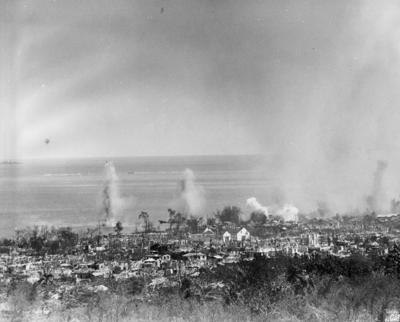ON June 11, 1944, life in the Marianas changed drastically.
Change had already begun. Japanese reinforcements had begun to arrive throughout the Mariana Islands in anticipation of an American invasion, pushing civilians out of their homes to make room for soldiers. Men, women, and children were forced to help build defensive positions.
American aircraft carriers had visited the Marianas in February. For two days, they destroyed communication centers, Japanese aircraft, and Japanese shipping, then disappeared back over the horizon. The damage they did that day, was only preparatory to the invasion. The strike on June 11, 1944 would be day one of Operation Forager, the American campaign to capture the Northern Mariana Islands and re-capture Guam.
Rear Admiral Marc Mitscher, commanding of a task force of 15 aircraft carriers with a thousand aircraft had planned to hit the Marianas on June 12. However, his fleet was discovered by Japanese scout planes on the morning of the 11th. Of his own volition, Mitscher radioed Admiral Nimitz, "We will fight our way in," and begin his mission — establish and maintain air superiority throughout the invasion.
To accomplish this task, Mitscher divided his carriers into four subgroups. The northern group would neutralize Pagan, Iwo Jima, and Chichi Jima, shooting down enemy planes and potholing their runways. The southern group would neutralize any aircraft that may have been shifted to Truk or Palau. The other two groups would wreak havoc on Guam, Rota, Tinian and Saipan.
After doing as much damage as possible, Mitscher's air fleet returned to their carriers , but were back at work early the next morning, June 12, attacking with the sunrise to their backs and in their enemy's eyes. Air superiority was established before dark.
On the morning of June 13 a fleet of new battleships arrived and began the naval bombardment of the Marianas — Saipan, Tinian, and Guam. Although they laid barrage after barrage of giant shells against the islands, they were largely ineffective. The crews were too green to hit designated targets.
Then, on the 14th, the old battleships, raised from the muddy bottom of Pearl Harbor and reconditioned, arrived in the Marianas. Peering at the ocean from his command station atop Mt. Tapochau, Admiral Chuichi Nagumo, who had lead the attack on Pearl Harbor then lost the battle of Midway, was shocked to see the ghosts of Pearl Harbor, the ships he had sunk, now shooting at him — with relish. The battle-hardened crew aboard these veteran ships shot straight and hit their pre-identified target, then targets of opportunity.
That night, the invasion fleet arrived. The entire fleet was so large, even a pilot could not see their entire fleet, stretching from horizon to horizon the length of the Marianas.
The following morning, June 15, 1944, the 2nd and 4th Marine Divisions began landing north and south of Sugar Dock in Chalan Kanoa. Unfortunately, the "intelligence" team at Pearl had underestimated the number of defending Japanese soldiers and sailors by 50%. As a result, the casualties on Day 1 at Saipan were twice as many as expected. Worse yet, it forced Admiral Spruance, in command of the 5th Fleet, to delay the invasion of Guam from June 18, to July 21, giving the Japanese defenders and extra five weeks to move their defensive installations south to Asan and Agat, the American landing beaches.
For those who have a copy of “Saipan: The Beginning of the End” by Major Carl W. Hoffman, USMC, now is the time to pull it out and follow the battle from day to day. If you don't, paperback copies are inexpensive online. It is also worthwhile to spend time with family and think about what it must have been like to be here 79 years ago as the Americans wrested Saipan from its Japanese defenders.
DON A. FARRELL
Marpo Heights, Tinian















